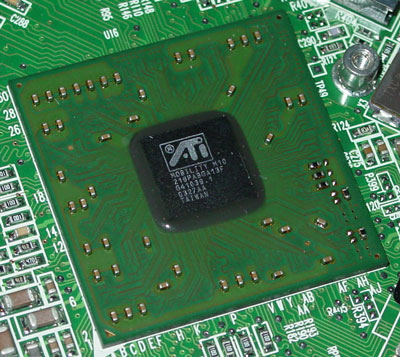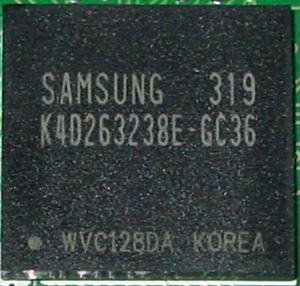Voodoo Envy M:855 Part 1 - Athlon 64 DTR and Mobility Radeon 9600 Pro
by Andrew Ku on November 4, 2003 5:45 PM EST- Posted in
- Laptops
Mobility Radeon 9600 Pro - OverDrive?
So with all the demand for Mobility Radeon 9600, it seems that design wins were in short supply about a month ago. Much has changed since then, as several large system vendors have picked up the product. It is interesting to note that in some cases, the NVIDIA GeForce FX Go5650 is being marketed toward the high-end mobile market; all the while the same company is targeting the ATI Mobility Radeon 9600 toward the mainstream mobile market.
The biggest difference between the Mobility Radeon 9600 (M10) and Mobility Radeon 9600 Pro (M10 Pro) is the employment of GDDR2-M and higher clock speeds on the latter. This is in addition to OverDrive, which marks the first time overclocking of any kind has been announced for the mainstream mobile market. Mobility Radeon 9600 Pro based notebooks seem to be popping up here and there, but we would make a note of caution to prospective buyers, as no current Mobility Radeon 9600 Pro based system has the ability to take advantage of this feature.
For OverDrive to be functional, there are several prerequisites: the BIOS for the graphic processor must have this feature enabled, the thermal diode to monitor temperature, and some sort of a logic circuit to retrieve and act upon the information from the thermal diode. This is in addition to the obvious thermal issues that this feature brings up. The decision to implement these features (and ultimately OverDrive) is left up to system vendors. We have been informed that we may see some laptops with the ability to enable OverDrive in quarter one or two of 2004. This is a feature we are still teething to see, particularly its effect on performance, as well as battery life.
Meanwhile, the Voodoo Envy M:855 we received uses a discrete Mobility Radeon 9600 Pro with 64MB of onboard Samsung MicroBGA 3.6ns DDR video memory. Obviously, the Envy M:855 cannot enable the OverDrive feature, as this is the case with all the current Mobility Radeon 9600 Pro based notebooks.
Voodoo Envy M:855's Mobility Radeon 9600 Pro

Click to enlarge.
Voodoo Envy M:855's Samsung 3.6ns MicroBGA DDR video memory

Apparently, there is even more confusion over what qualifies for the Pro postfix. Much of what we know now about Mobility Radeon 9600 Pro comes from our preview earlier in March. Within the last forty-eight hours, our talks with Voodoo have revealed some interesting developments. Voodoo tells us that ATI has two main perquisites for the Pro dubbing: 350MHz core clock and 128MB of video memory. It seems that the GDDR2-M requirement has been dropped. The regular Mobility Radeon 9600 has official clock speeds of 350MHz/300MHz, but these aren’t hard and fast guidelines, as it is up to system vendors to decide the appropriate clock speeds for their thermal budget.
While our Voodoo Envy M:855 came with only 64MB, it is of the Mobility Radeon 9600 Pro yield batch, and for that reason we call it such. This is in addition to the fact that these perquisites didn’t come to light until just now. The reason behind the chip's "M10" physical marking is because the chip is an engineering sample, otherwise it should be marked "Mobility Radeon 9600 Pro."
The clocks for the Mobility Radeon 9600 Pro on our M:855 sample were 351MHz core clock and 202MHz memory clock, which are only so odd in the fact that they are not divisible by 5MHz. Voodoo’s refresh of M:855 should come with 128MB of video memory and should have an excess of 250MHz in memory clock. We aren't sure if they are going to stick with the Samsung video memory, which is on our M:855 sample, or will switch to the integrated memory package. However, the Samsung 3.6ns MicroBGA DDR memory is rated at 275MHz, which should leave some head room to increase the memory clocks. Initially, it will be shipping with what we are sampling: Mobility Radeon 9600 Pro with 64MB of video memory. Both Voodoo and AnandTech have been receiving conflicting reports on the required memory clock for the Pro postfix. Once we get more solid information that indicates what is correct, we will report back.
For those that claim that their Mobility Radeon 9600 Pro doesn’t show up in the control panel or Window XP’s display settings, we have noticed that in Window XP’s display settings, the Mobility Radeon 9600 Pro will not be identified as such. Instead, it is often times identified as Mobility Radeon 9600 or M10.










24 Comments
View All Comments
Madcat207 - Tuesday, November 4, 2003 - link
No offence, but bad review.The Voodoo was put up against no real competition, so of course it won. Why did anandtech not bother with getting a Sager 5680 or 8890 to compare with, since those are P4 machines with real 9600 pros....
TheInvincibleMustard - Tuesday, November 4, 2003 - link
1) Is it hard to have the product in question (ie, the one being reviewed) highlighted in some way on the graphs? It can't be that hard to do the bar in red or whatever. Granted, when comparing the M10 to the Go5650, there's not as much sense, but when comparing 10 or so CPU's it'd sure be nice to quickly identify what stands where.2) Should the X2 performance scores with 4xAA/8xAF be taken with a grain of salt? Why does the M10 increase approx 25% going from 1024x768 to 1280x1024 ... ?
Adul - Tuesday, November 4, 2003 - link
The battery life performance will come in part 2 of this review.AlexWade - Tuesday, November 4, 2003 - link
Deat AT:What is the battery life on this notebook? I but notebooks based on battery life, not performence.